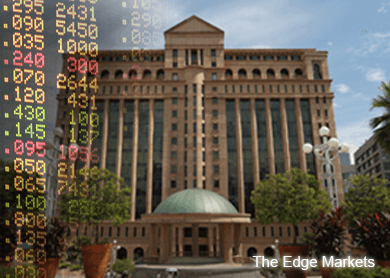
This article first appeared in The Edge Financial Daily, on April 8, 2016.
US equity markets gained on Wednesday, aided by a rise in oil prices and a surge in healthcare stocks. The US dollar fell with Treasuries as the Federal Reserve meeting minutes affirmed that policymakers are not in a hurry to raise interest rates amid persistent concerns about slowing growth abroad. The S&P 500 Index rose 21.49 points to 2,066.66 while the Dow Jones Industrial Average gained 112.73 points to end at 17,716.05.

In Malaysia, the FBM KLCI moved in a very narrow range of 14.24 points for the week with lower volumes of 1.5 billion to 1.71 billion shares traded. The index closed at 1,724.29 points yesterday, up 7.28 points from the previous day as blue-chip stocks like Astro Malaysia Holdings Bhd, Tenaga Nasional Bhd and UMW Holdings Bhd caused the index to rise in very late afternoon nibbling activities. The ringgit weakened against the US dollar at 3.9150 despite Brent crude rising to US$39 (RM152.49) per barrel.
The index rose on a rally from the 801.27 low (October 2008) to its 1,896.23 all-time high (July 2014) and it represented an extended Elliott Wave “flat” rebound in a “pseudo-bull” rise completed. The next few months’ index price movements since July 2014 comprised key swings of 1,671.82 (low), 1,867.53 (high), 1,503.68 (low) and 1,727.41 (high).
The index’s decline from 1,867.53 (April 2015) to 1,503.68 (August 2015) is in a perfect 1.62 ratio of the initial down-thrust from the high of 1,896.23 (July 2014) to the 1,671.82 low (December 2014). The subsequent rebound from the 1,503.68 low stalled at the 1,727.41 high, which is also an almost perfect upward 62% retracement of the 1,867.53 to 1,503.68 move.
The index’s next two minor swings comprised a minor low of 1,622.84, which then stalled at the 1,706.25 minor high on Dec 30, 2015. Its persistent weaker price action in January 2016 was in tandem with the softer tone of global markets and the index troughed at 1,600.92 on Jan 21, 2016. The index’s next rebound from the 1,600.92 low surged to a new recent high of 1,726.55 on March 23, 2016.
The index’s daily signals are mixed, with its Commodity Channel Index (CCI), Directional Movement Index (DMI) and oscillator indicators showing chart buy signals. Its Moving Average Convergence Divergence (MACD) and stochastic have issued overbought sell signals from lofty levels. As such, the index’s support levels are seen at 1,651, 1,676 and 1,709 levels, while heavy profit-taking at resistance areas of 1,724, 1,728 and 1,752 will cap any index rebound.
The FBM KLCI’s 18-day and 40-day simple moving averages (SMAs) depict an emerging trend for its short-term daily chart. The index’s price bars are finally above the 50-day and 200-day SMAs, and this depicts a better upward phase for the FBM KLCI in the medium to longer term too.
A key level to note for the FBM KLCI is 1,728.54, which is the actual 62% Fibonacci retracement of the 1,867.53 high against the 1,503.68 low. If the FBM KLCI is unable to surpass this level, then the onus will move towards the downside. Should the FBM KLCI can surpass this level, then a firmer trend will persist.
Despite the steady tone of the FBM KLCI , we are recommending a chart “sell” on AMMB Holdings Bhd (AmBank). The company provides merchant and commercial banking, retail financing, stock and futures broking, and investment advisory. A check on the Bloomberg consensus reveals that 21 research houses cover this stock, with 3 “buy” calls, 7 “sell” calls and 11 “hold” calls.
Maybank Investment Bank’s analyst recently downgraded AmBank from a “hold” call to a “sell” call with a target price of RM4.10 from RM4.90. Although AmBank’s nine-month financial year 2016 (9MFY16) results were within expectations, the group’s earnings growth outlook is likely to remain subdued and the return on equity is projected to be just over 8% for FY17. AmBank recently appointed a new chief executive officer, Datuk Sulaiman Mohd Tahir, almost a year after the resignation of Ashok Ramamurthy at the end of January 2015.
AmBank’s chart trend in the daily, weekly and monthly time frames is firmly down. From a weekly Wave 5 high of RM7.22 (August 2013), its prices have turned down strongly in the daily, weekly and monthly time frames to a weekly Wave 3 low of RM4.13 (August 2015). AmBank may be tracing out a downward Symmetrical Triangle, with potential to break towards the downside in due course.
As prices broke above its recent key critical support levels of RM4.51 and RM5.02, look to sell AmBank on any rallies to its resistance areas as the moving averages depict a very firm short- to long-term downtrend for this stock. The daily and monthly indicators (like the CCI, DMI and MACD) have issued clear sell signals, and now show firm and obvious indications of AmBank’s eventual plunge towards much lower levels.
It would attract very weak buying activities at support levels of RM3.78, RM4.13 and RM4.34. We expect AmBank to witness very heavy activities at its resistance levels of RM4.46, RM4.51 and RM5.02. Its clear downside targets are located at RM3.55, RM3.45, RM3.02 and RM1.95.
Lee Cheng Hooi is the regional chartist at Maybank Kim Eng. The views expressed in the article are the opinions of the writer and should not be construed as investment advice. Please exercise your own judgement or seek professional advice for your investment decisions. Technical report appears every Wednesday and Friday.